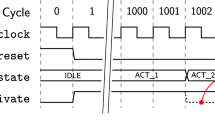Abstract
Today’s Integrated Circuit (IC) industry is suffering from piracy, overbuild ICs, and hardware Trojans. One way to protect ICs is logic locking. Logic locking is done by inserting extra logic to the original design’s netlist such that correct outputs are produced only when the correct key is applied. However, the determination of locations to insert logic is a computationally expensive process. In this paper, we propose a fault emulation technique to speed up the process of determination of fault locations. Our fault emulation technique enables dynamic multiple fault injection as well as real-time fault impact computation in a single FPGA configuration. The effectiveness of the proposed emulation technique is evaluated with ISCAS’89 sequential benchmark circuits and results are presented.









Similar content being viewed by others
References
Alkabani YM, Koushanfar F (2007) Active Hardware metering for intellectual property protection and security. In: Proceedings of USENIX security symposium on USENIX security symposium, Berkeley, pp 20:1-20:16
Barak B, Goldreich O, Impagliazzo R, Rudich S, Sahai A, Vadhan S, Yang K (2012) On the (Im)possibility of obfuscating programs. J ACM 59(2):6:1-6:48
Chakraborty RS, Bhunia S (2011) Security against hardware Trojan attacks using key-based design obfuscation. J Electron Test Theory Appl 27(6):767–785
Chakraborty RS, Bhunia S (2009) Security against hardware Trojan through a novel application of design obfuscation. In: Proceedings of international conference on computer-aided design, San Jose, pp 113–116
Cheng KT, Huang SY, Dai WJ (2006) Fault emulation: a new methodology for fault grading. IEEE Trans Comp-Aided Des Integ Cir Sys 18(10):1487–1495
Dadda L (1965) Some schemes for parallel multipliers. Alta Frequenza 34:349–356
Gören S, Ozkurt O, Yildiz A, Ugurdag HF, Chakraborty RS, Mukhopadhyay D (2013) Partial bitstream protection for low-cost FPGAs with physical unclonable function, obfuscation, and dynamic partial self reconfiguration. Comput Electr Eng 39(2):386–397
Gören S, Yildiz A, Ozkurt O, Ugurdag HF (2011) FPGA bitstream protection with PUFs, obfuscation and multi-boot. In: Proceedings of international workshop on reconfigurable communication-centric systems-on-chip, Montpellier, pp 1–2
KPMG (2006) Managing the risks of counterfeiting in the information technology. http://www.agmaglobal.org/press_events/press_docs/Counterfeit_WhitePaper_Final.pdf. Accessed 14 October 2015
Lu SK, Huang SY, Wu CW, Chen YM (2011) Speeding up emulation-based diagnosis techniques for logic cores. IEEE Des Test Comput 28(4):88–97
Rostami M, Koushanfar F, Karri R (2014) A primer on hardware security:Models, methods, and metrics. Proc IEEE 102(8):1283–1295
Parhami B (2000) Computer arithmetic: algorithms and hardware designs. Oxford University Press, New York
Plaza SM, Markov IL (2015) Solving the 3rd-shift problem in IC piracy with test-aware logic locking. IEEE Trans Comput Aided Des Integr Circuits Syst 34(6):961–971
Rajendran J, Pino Y, Sinanoglu O, Karri R (2012) Security analysis of logic obfuscation. In: Proceedings of Design Automation Conference, San Francisco, pp 83–89
Rajendran J, Zhang H, Zhang C, Rose GS, Pino Y, Sinanoglu O, Karri R (2015) Fault analysis-based logic encryption. IEEE Trans Comput 64(2):410–424
Roy JA, Koushanfar F, Markov IL (2008) EPIC: ending piracy of integrated circuits. In: Proceedings of conference on design, automation and test in Europe, Munich, pp 1069–1074
Sanchez E, Sterpone L, Ullah A (2014) Effective emulation of permanent faults in ASICs through dynamically reconfigurable FPGAs. In: Proceedings of field programmable logic and applications, Munich, pp 1–6
SEMI (2008) Innovation is at risk as semiconductor equipment and materials industry loses up to 4 billion annually due to IP infringement. http://www.semi.org/en/Press/P043775. Accessed 14 October 2015
Suh GE, Devadas S (2007) Physical unclonable functions for device authentication and secret key generation. In: Proceedings of design automation conference, San Diego, pp 9–14
Ugurdag HF, Keskin O, Tunc C, Temizkan F, Fici G, Dedeoglu S (2011) RoCoCo: row and column compression for high-performance multiplication on FPGAs. In: Proceedings of design & test symposium (EWDTS), Sevastopol, pp 98–101
Wallace CS (1964) A suggestion for a fast multiplier. IEEE Trans Electron Comput 13(1):14–17
Wieler RW, Zhang Z, McLeod RD (1995) Emulating static faults using a Xilinx based emulator. In: Proceedings of IEEE symposium on FPGA’s for custom computing machines, Napa Valley, pp 110–115
Author information
Authors and Affiliations
Corresponding author
Additional information
Responsible Editor: M. Tehranipoor
This project is supported by the Scientific and Technological Research Council of Turkey (TUBITAK), under contract EEEAG/114E022.
Rights and permissions
About this article
Cite this article
Gören, S., Gürsoy, C.C. & Yildiz, A. Speeding Up Logic Locking via Fault Emulation and Dynamic Multiple Fault Injection. J Electron Test 31, 525–536 (2015). https://doi.org/10.1007/s10836-015-5544-2
Received:
Accepted:
Published:
Issue Date:
DOI: https://doi.org/10.1007/s10836-015-5544-2




